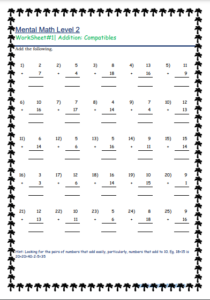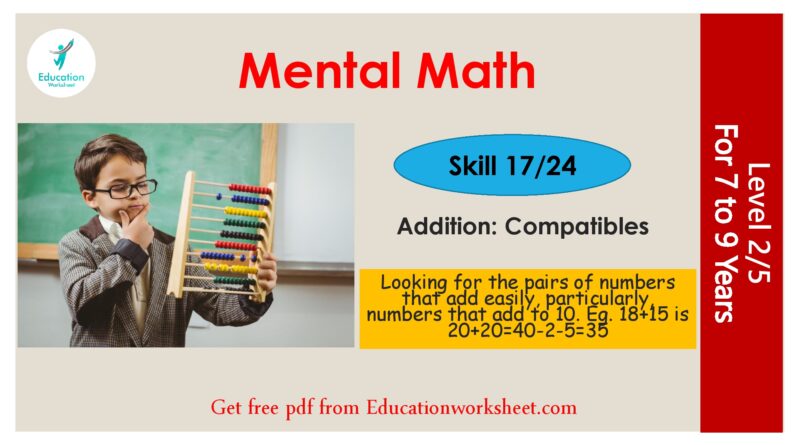Quick Compatibles Addition Strategies
Quick Compatibles Addition Strategies
Quick Compatibles Addition Strategies When you’re adding numbers, there are several strategies you can use to make the process quicker and more efficient. Here are some quick addition strategies:
It means the numbers that are easy to add, subtract, multiply, or divide are compatible. Quick Compatibles Addition Strategies Also, these numbers are close in value to the actual numbers that make estimating the answer and solving problems easier. For instance, if we add 485 and 549, we get our answer as 1034.
For example

- Counting Up: Start with the larger number and count up by the value of the smaller number. For example, to add 7 + 4, start with 7 and count up by 4: 7, 8, 9, 10, 11. So, 7 + 4 = 11.
- Using Friendly Numbers: Break down numbers into parts that are easy to add. For example, to add 8 + 6, you can think of it as 8 + 2 + 4, which is easier to compute: 8 + 2 = 10, and then 10 + 4 = 14.
- Number Bonds: Visualize the numbers as parts of a whole. For instance, when adding 9 + 6, you can think of it as 9 + 1 (to make 10) + 5, which equals 10 + 5 = 15.
- Near Doubles: If you have numbers that are close to doubles (e.g., 7 + 8), you can use the double and adjust strategy. Double one of the numbers (7 + 7 = 14) and then add the difference (8 – 7 = 1) to get the final answer: 14 + 1 = 15.
- Compensation: If you have numbers that are slightly different from each other, you can adjust one number to make the addition easier. For example, to add 47 + 38, you can add 2 to 38 to make it 40 and subtract 2 from 47 to make it 45. Then, add 45 + 40 = 85, and add back the adjustments (2 – 2 = 0), so the final answer is still 85.
- Left-to-Right Addition: Instead of adding from right to left (units, tens, hundreds, etc.), you can add numbers from left to right. For example, when adding 47 + 38, start with the tens place: 40 + 30 = 70, and then add the units: 7 + 8 = 15. Combine them to get 70 + 15 = 85.
- Using Mental Math Tricks: For numbers ending in 5, you can use the “5 and some more” rule. For example, to add 45 + 37, recognize that 45 + 5 = 50, and then add the remaining 32, resulting in 50 + 32 = 82.
- Chunking: Break the numbers into smaller, manageable chunks. For example, to add 386 + 497, you can add 300 + 400 = 700, 80 + 90 = 170, and 6 + 7 = 13. Then, combine the chunks: 700 + 170 + 13 = 883.
- Round and Adjust: Round numbers to the nearest multiple of 10, perform the addition, and then adjust for the rounding. For example, to add 47 + 68, round 47 up to 50 and round 68 down to 70. Then, add 50 + 70 = 120, and adjust by subtracting the rounding difference: 120 – (3 + 2) = 120 – 5 = 115.
These Quick Compatibles Addition Strategies can help you add numbers quickly and efficiently, and the choice of strategy often depends on the specific numbers you are adding and your personal preference. Practice with these techniques to become more skilled at mental addition.
What is the Quick Compatibles Addition Strategies?
How do I get better at Quick Compatibles Addition Strategies?
Improving your Quick Compatibles Addition Strategies skills involves practice, mental math techniques, and building a strong foundation in basic arithmetic. Here are some tips to help you get better at quick addition:
For example

- Master Basic Addition Facts: Ensure you have a strong grasp of basic addition facts, such as single-digit addition (e.g., 5 + 3 = 8) and double-digit Quick Compatibles Addition Strategies without carrying (e.g., 24 + 17 = 41). These should become automatic responses.
- Practice Regularly: Practice is essential to improve any skill. Spend some time each day practicing addition problems. You can use flashcards, worksheets, or online math games for this purpose.
- Break Down Numbers: When adding larger numbers, break them down into smaller, more manageable parts. For example, when adding 38 + 27, you can add 30 + 20 first and then add 8 + 7. This simplifies the problem and makes it easier to solve mentally.
- Estimation: Learn to estimate. Estimating helps you quickly gauge whether an answer is reasonable. For instance, if you’re adding 67 + 94, you can round these numbers to 70 + 90 to get a quick estimate of around 160.
- Practice Mental Math Techniques:
- Counting On: Start with one number and count up by the other number. For example, to add 7 + 5, start with 7 and count up 5 more (8, 9, 10, 11, 12).
- Use Doubles: If you’re adding a number to itself (e.g., 6 + 6), recognize it as a double and quickly double one of the numbers (6 + 6 = 12).
- Near-Doubles: If one number is close to a double of the other, take advantage of that. For example, for 7 + 8, notice that 7 is one less than 8, so it’s similar to 7 + 7 + 1.
- Practice Mental Math Daily: Try to solve Quick Compatibles Addition Strategies problems in your head whenever you encounter them in daily life. For example, when calculating a total at a store, mentally add up the prices of items.
- Use Visualization: Some people find it helpful to visualize a mental number line or an abacus when adding numbers mentally. Visual aids can make addition easier.
- Set Goals: Set specific goals for your improvement, such as increasing the speed at which you can solve addition problems or reducing errors. Track your progress and celebrate small achievements.
- Use Online Resources: There are many online resources and apps designed to improve mental math skills. They often include timed quizzes and interactive exercises to help you practice.
- Stay Calm: Maintain a calm and focused mindset when doing mental math. Anxiety and rushing can lead to mistakes. Take a deep breath and concentrate on the problem at hand.
Remember that improvement takes time, Quick Compatibles Addition Strategies so be patient with yourself. With consistent practice and the application of these techniques, you should see progress in your quick addition skills.

